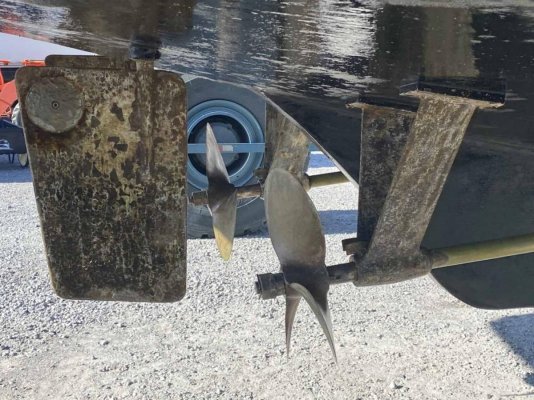magna 6882
Guru
- Joined
- Apr 20, 2020
- Messages
- 695
- Location
- USA
- Vessel Name
- Intrepid
- Vessel Make
- North Pacific/ NP-45 Hull 10
pulled the boat yesterday and the yard suggested prop speed coating for the prop and the rudder. Your thoughts.

Magna, I've had reasonable results with Petit prop coat, 18/24 months between recoating.
Easier to do than Pspeed, a lot less $$, lasts a lot longer than simple spray galv, but good prep/weather is still important. I used two spray cans, thin coats.
I'd stay with bottom paint on the rudder, ask a guru in your boat yard about whether your boat is over-zinced.
If your Propspeed only stayed on a month, you have an issue with the yard that applied it, not the product. It has been on my prop for 3 years, and looks like the day they did it. Prop has run about 600 hours in that time.
Really?
Never heard of prop speed or the several other clones?
Amazing. (-;
We have used Prop Speed on our boats, which a used primarily in the Chesapeake, with very satisfactory results. It is a covering that must be applied in accordance with the manufacturers instructions. We usually have little to no growth in the running gear and what does attach itself to the props can easily be scrapped off with a plastic scrapper without damage to the coating.
Lighten up princess
Seeing how Simi is being a jerk, can someone tell me what the prop speed it without a stupid answer? Thx
We just applied propglide on our gear yesterday.
The guy at the yard who applied it says it is pretty much the same as propspeed as far as he can tell.
Same application specs as well but only $200 on Amazon. View attachment 122657
Learned something new.They put your prop nuts on backwards, the half height nut should be on first and the full height nut should be put on last. When you tighten the second nut it partly unloads the first nut. When the hal height nut is second and tightened up it will partly unload the full height nut. You want the prop riding on the full height nut. To seat the prop you use the full height nut first and then remove it and put on the half height nut first.
To seat the prop you use the full height nut first and then remove it and put on the half height nut first.
We just applied propglide on our gear yesterday.
The guy at the yard who applied it says it is pretty much the same as propspeed as far as he can tell.
Same application specs as well but only $200 on Amazon. View attachment 122657
I’ve DIY propspeed three times. It. Is. Hard. Depending on conditions you can easily be barely a minute inside your window between the first product and the second and run out of time. Miss the window and it doesn’t work.
It’s probably the best product, not really expensive when it works and you get a full 3 years. Really expensive when somebody cuts corners and it doesn’t.
